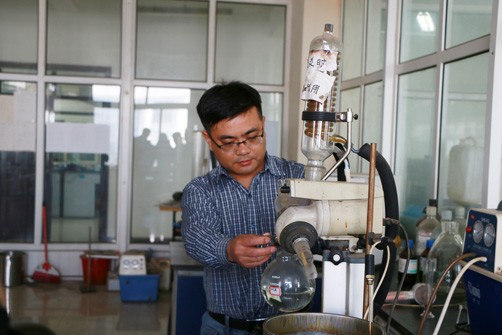Dr. Meng Qingtao developed a molecular imaging probe to lock the "cancer" early

At present, the best way for humans to deal with "cancer" is to find out early and treat them early. So, is there an instrument that can quickly and quickly diagnose and diagnose major diseases such as cancer, just like blood glucose meter? Molecular imaging probe research conducted by Dr. Meng Qingtao of Liaoning University of Science and Technology is expected to overcome the common problem of cancer by monitoring the specific expression of active markers at the cellular level in early stages of cancer and other diseases.
Medical imaging technology is like a doctor's "eye", but it can only observe changes in the human anatomy, and can not explain the cause of the disease, nor answer complex clinical problems. Molecular imaging technology can not only “see†but also “see earlyâ€. It can “see†the physiological and pathological changes at the biological cell or molecular level, and explore early markers of various diseases (bioactive molecules, ions). Abnormalities such as free radicals, etc., provide clinical warning information in the early stage of the formation of the lesion, and truly realize early diagnosis and early treatment.
"'Molecular imaging technology' just borrows the 'molecular imaging probe' to lock the 'cancer' as early as possible, and then catch its throat. So, if the 'cancer' accidentally picks up this magical probe, In particular, the fluorescent molecular probes with strong specificity, high sensitivity, and quickness are inevitably 'lying in the middle of the gun.†Meng Qingtao vividly described the role of the "probe".
At the beginning of 2014, Meng Qingtao and several members of the team developed fluorescent molecular probes to successfully achieve specific capture and quantitative analysis of inorganic phosphates and sulfur ions in human breast cancer cells (MDA-MB-231). Highly recognized by experts in the field.
During the course of the study, they were pleasantly surprised to find that some of the probes were concentrated in certain functional areas after entering the cells. Combined with this phenomenon, Meng Qingtao believes that it is feasible to design a fluorescent molecular probe that targets the localization function of subcellular structures through rational regulation of the structure. His idea was validated experimentally. They successfully developed a series of fluorescent molecular probes with organelle targeting, which enabled high specific detection of important markers in organelles.
On the basis of reviewing a large amount of literature, Meng Qingtao repeatedly experimented and successfully developed a fluorescent molecular probe that can distinguish cysteine ​​from complex compounds such as amino acids and thiols, that is, using probes to successfully treat human urine in half. The content of cystine was quantitatively analyzed. Subsequently, they developed lysosomal-targeted histidine fluorescent probes and cytoplasmic-targeted iron-ion fluorescent probes, which were successfully applied to human breast cancer cells (MDA-MB-231) and human glioblasts. Tumor cells (U-343MGa) and other cell lines. This series of molecular imaging probes have shown potential applications in early warning of major diseases and screening of diseases.
Meng Qingtao said: "Like the use of blood glucose meters to detect blood sugar levels, we have developed a series of imaging probes that can detect real-time and quantitative information on the content, distribution and status of biologically active species in subcellular structures in humans. Probes can analyze active ions and molecules at the molecular or cellular level, explore the laws of disease occurrence and development, and hope to provide health warning information before the formation of lesions."
Hematology analyzer clinical also known as blood cell analyzer, blood cell analyzer, blood cell analyzer, blood cell counting instrument. Hematology analyzer not only improves the accuracy of experimental results, but also provides many experimental indicators, which plays an important role in the diagnosis and differential diagnosis of diseases. Hematology analyzer is one of the most widely used instruments in hospital clinical examination.
Multi-segment counting method, high antinterference.
Automatic maintenance and one- click trouble shooting.
Automatic cleaning & maintenance of the liquid system
at regular intervals.
Intelligent anti-clogging, burning, back flushing and soaking.
More durable columnar Pt electrode.
Up to 60 samples/hour.
Cost effective, less sample volume,
only 15 μL sample for each test.
No external computer required,
automatic result print with in-built printer.
L arge touch screen, high-definition color monitor,
supporting operation with rubber gloves.
Patented reagent volume detection, ZERO reagent residue.
Hematology Analyzer,Hematology Analyzer Cbc Machine,5 Diff Hematology Analyzer,3 Diff Hematology Analyzer
Changchun ZYF science and technology CO.,LTD , https://www.zyf-medical.com